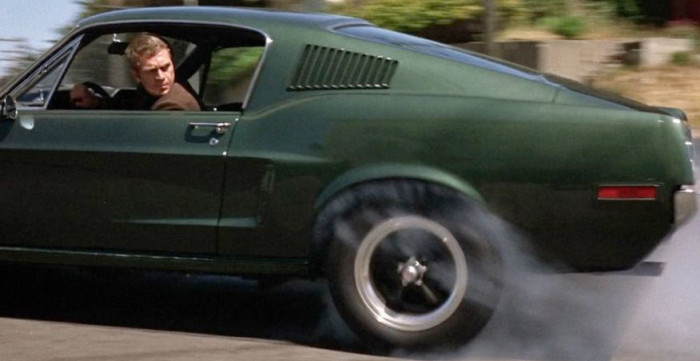Edgar Wright Gushes About 10 Movies That Influenced 'Baby Driver' (Part 1)
(Welcome to Cinematic Inspirations, a series where filmmakers talk about the movies that inspired their latest release. In this edition: the first of two conversations with Edgar Wright on the movies that inspired Baby Driver.)
Leading up to the release of Baby Driver, director Edgar Wright was a guest programmer at the British Film Institute for a series of films under the banner Car Car Land. The filmmaker rounded up 10 of the movies that influenced Baby Driver in some way for cinephiles in London to enjoy. Since not everyone can attend those screenings and hear all the wonderful things he has to say about these movies, some of which he introduced himself, we wanted to hear from the man himself why he loves these movies and how they inspired his new film, which is being called a "dazzling car chase musical."
A little over a week ago, we had an extensive phone call with Edgar Wright where he laid down his passion for these 10 movies and provided some fun facts. Since this is such an extensive conversation, we've split it up into two parts. Below is the first part going through the first five movies, and we'll be posting the second part tomorrow with the remaining five.
First of all, here's Edgar Wright explaining how he chose the films for BFI's Car Car Land season:
What I did with this season is I picked movies that had car chases of my youth. So there are not as many recent ones because I capped it where I started making movies myself, which was around 1994. I chose the car chases that really inspired me when I was younger. Because I had the original idea for Baby Driver in 1995 so I was thinking about the films up until that point.
Let's get right into the first five movies that inspired Baby Driver and why Edgar Wright loves them so much. Anything below that appears in italics (other than the titles) is me – everything else is Wright in his own words.
Bullitt (1968)
Why Edgar Loves It: I think when Bullitt came out it was notable in terms of it having a car chase sequence that fully dominates the movie, and the whole film is building up to it. Then when you get to the actual sequence, maybe you can check how long it actually is, but I want to say it's six or seven minutes long. It's a wordless action scene that feels like such an influential sequence not just in terms of inspiring hundreds of other car chases in movies, but also because the placement of the car chase where the plot builds up to centrepiece set up of a cat and mouse chase between Steve McQueen and Bill Hickman with a Mustang and a Charger.
It's one of those sequences where, despite film making having become advanced in the last 49 years, the photography is still extraordinary – I can't really think of the hills of San Francisco without thinking of the Bullitt chase. Not only is McQueen and his vehicle iconic, but just the cars themselves going over those hills was incredible. And I think there's something in the fact that it was a British director, Peter Yates, shooting his first US movie, that was interesting to me, when British directors take a foreign eye to an international location. And you've gotta think that Peter Yates must be part of that decision, the idea of being in San Francisco and saying, "Oh, we should do a chase on these hills."
The other thing I really like about it – and I used to have a bit of dialogue in Baby Driver about this that was cut out of the draft – there was a whole part of scene about somebody playing the chase music from Bullitt. "Get the soundtrack from Bullitt, so we can play the chase music." And then someone points out that there is no chase music in Bullitt, the music is actually the sound of the engines and the wheels screeching. Because Lalo Schifrin's score, this incredible cue called "Changing Gears" is leading up to the chase kicking off. Then the chase explodes and it's an amazing sequence with no score. I just love how pure it is.
Another interesting thing about it is McQueen seems to be doing most of his own driving. It was one of the first movies to lock cameras to the cars and shoot the actors for real, for the most part. There's no process work. Sometimes when you see earlier car chases, even in Bond films, it's done with back projection, but Bullitt feels very real and I think that's the reason why it feels so revolutionary at the time.
Baby Driver Note: In the same way that Edgar Wright can't help but think about Bullitt when he sees the hills of San Francisco, you'll be hard-pressed to think about any movie other than Baby Driver if you're ever in Atlanta, because this movie tears through that city and lets it appear as itself, unlike most blockbusters that let it double for other cities.Edgar's Fun Fact: Bill Hickman, the guy who's pursuing Steve McQueen, the one who buckles in, is also the stunt driver in The French Connection. He's the guy who's playing Popeye Doyle's, or Gene Hackman's, stunt double. He is also known for being the first on the scene at James Dean's fatal crash, because they were driving to the speedway together. Bill Hickman was in the car behind and was the guy who was first on the scene when James Dean and his passenger were in that horrific crash.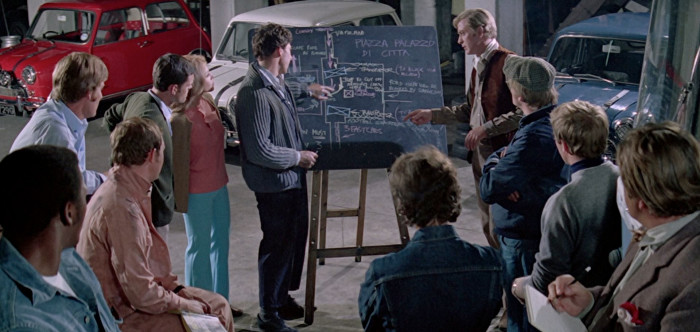
The Italian Job (1969)
Why Edgar Loves It: When I was thinking about Baby Driver, I knew in my head that it probably wasn't a British film. Aside from Peter Yates' Robbery, there are not too many car chase movies in the United Kingdom, especially in recent years as the center of London had become car-chase-proof. Someone texted me the other day, "What about The Italian Job?" And I said, well, the main chase is in Turin, that's where the Mini chase is.
As a kid, it's probably one of the first car chases I remember seeing in a movie. I especially loved it because the Minis are red, white and blue. It's such a product of the swinging 60s coming out during a real boom time for London, when it was the cultural epicentre of the world at the time. The thing I love about this film, apart from the stunt driving, is just how fun it looks and feels. This isn't a gritty movie like some of the other ones, this is a caper movie. The other thing that's extraordinary to me about this film is Quincy Jones' music. The score, particularly that track called "It's Caper Time", is incredible. I have very fond memories of this movie.
I also absolutely adore the ending of The Italian Job. The fact that it ends on a literal cliffhanger is fantastic. It seems like a studio wouldn't let you do something like that today. It's such a great ending and even the very final line by Michael Caine, when the bus is teetering on the cliff with the gold on one end and the gang on the other end, and he turns and says, "Lads, I've got an idea." Then it cuts to a helicopter shot and Quincy's score kicks in and that's the ending. What an amazing, highly memorable ending, the perfect way to end a heist movie like that.
I think about this movie a lot and it's an exceptional, interesting film besides just the car chase.
Baby Driver Note: Much like The Italian Job, Edgar Wright's Baby Driver isn't just about the car chases. Sure, they're outstanding and practical, but it's the characters at the center of this story and the style that presents it that would make this a fantastic film if it didn't have any of the car chases.Edgar's Fun Fact: In the UK, it is a very famous movie. It's one of those Christmas holiday standbys that's always on TV. That Michael Caine line, "You were only supposed to blow the bloody doors off," is one of the most famous British one-liners of all time.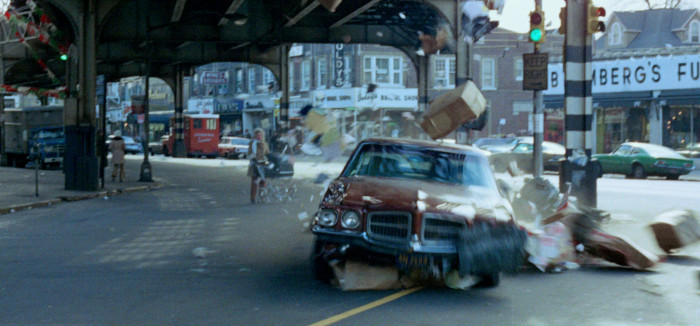
The French Connection (1971)
Why Edgar Loves It: Why is The French Connection regularly called one of the greatest chases of all time? Because it builds out of some unique stakes, and it's also unusual in that it's not a car chase between two cars, it's a car chase between a car and an elevated train. The idea that Popeye Doyle, played by Gene Hackman, can barely see his prey is thrilling. He's looking at the train from underneath the track. It's such a unique and interesting use of geography and I think the way that it's shot and edited together is a master class in terms of establishing the spatial geography between the hero and the villain in their separate vehicles.
The fact that you've also got all of the amazing car chase footage they did for real, like bombing down that street with a POV shot going 50 miles an hour. That's something they would absolutely not let you do in this day and age. It's too dangerous. The legend goes that they just gunned it for real on a Sunday morning. Again, Bill Hickman, the guy in from Bullitt was the driver in this sequence. They just went into real traffic and he just went for it. That's what that point-of-view shot you're looking at is.
On top of that, you also have the suspenseful situation with the killer on the train. Shooting the guard, pulling the gun, the people on the train all panicking. It's kind of engineered for maximum tension. It still stands up today, because even though photography has gotten more advanced, it's just an astounding scene. Some of the other films on this list are car chase movies, but is a great movie that happens to have a great car chase in it. If you took the car chase out of French Connection it would still be amazing, and it's just a testament to it being one of the greatest classics of all time.
Baby Driver Notes: If there's one moment that feels as creative as chasing a train in The French Connection, it's a highway sequence that you've seen in the trailer where a big truck gets swept to the side at high speeds by another truck and ends up stuck perpendicularly under the bed of a semi-truck as the other truck continues to barrel into it.Edgar's Fun Fact: Before presenting the movie at the BFI, Edgar e-mailed William Friedkin about the movie and how the chase came to be, to which the filmmaker said, "The French Connection chase was inspired by the city of New York and the fact that I loved to travel by subway and elevated trains. In many ways, it was a response to the chase in Bullitt – in that I knew I couldn't top that car chase, so I had to do something different."Furthermore, Edgar also asked British film critic Mark Kermode why the chase has endured after all these years and he said, "Because, unlike so many car chases, it has a REAL senses of DANGER Partly this is due to the fact that it was, actually, dangerous to shoot! When we retraced the route for The Poughkeepsie Shuffle documentary, we had Randy Jurgensen in the car with us and he was recounting how 'We were doing about 45/50mph here' – we couldn't even get above fifteen miles an hour! The roads are too narrow, too crowded! Billy said that he told driver Bill Hickman he was 'a pussy'; that he hadn't shown him anything 'real'. He did this to fire him up. Hickman apparently rose to the bait. He said: "you wanna see real? Are you brave enough to get in the car with me?" Billy WAS, and Hickman went for it. When they creased the city bus ... that's real! The whole chase has a genuine sense of jeopardy. – a sense that someone actually could get hurt. Like the rest of the movie, it looks like a documentary; you believe it's happening. Incidentally, editor Jerry Greenberg cut the chase to the sound of Black Magic Woman by Santana. If you run that track over the chase, it cuts together!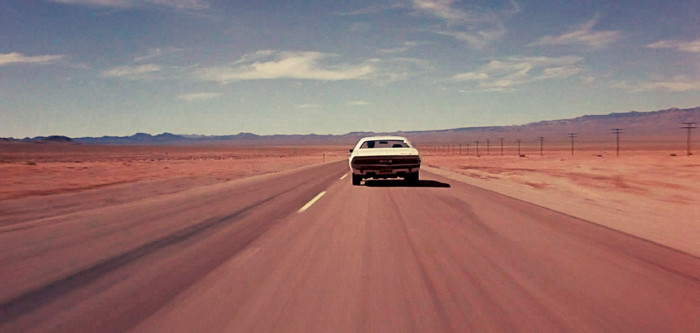
Vanishing Point (1971)
Why Edgar Loves It:Vanishing Point by Richard Sarafian is a movie that I thought a lot about for Baby Driver because it has one point in the movie that really stuck with me. When Kowalski is in his white Challenger there's one police pursuit in it that spans over two songs. One song ends and another one starts, and I had never really seen that in a movie before, the idea of a car chase set to rock music and also having a song end and another one starts. Baby Driver is a very different movie from Vanishing Point, but it's something that really stuck with me, this idea of it being a musical action head-trip.
I really also like that this movie feels like Jack Kerouac at 150 miles per hour because of the existential feel of the story. The ending of the movie, without giving too much away, is that you see Kowalski die, you see his car crash, but just before you see a freeze frame with another car passing him. In the freeze frame, Kowalski's car disappears and the other car going the other way carries on. I always interpret that as Kowalski's rebel spirit has transferred into the other car. It's this great action film, and it's very much a product of the early 1970s being in the vein of Easy Rider, like a spiritual journey as much as it's an action film. And I really like that ending, the myth of that character made even more vivid by the fact that it has a DJ waxing lyrical about him the entire time.
Baby Driver Note: Influenced by the aforementioned double soundtrack cue in Vanishing Point, the entire soundtrack for Baby Driver has pretty much every song ending and another one beginning. Sometimes there are pieces of score in between, but otherwise the soundtrack drives the movie just as well as Baby drives a car. It's seamless and mesmerizing.Edgar's Fun Fact: There's a scene in Baby Driver where Ansel Elgort's character is making these cut-up mixes, songs of sounds and dialogue, mostly about him. And I thought there was an element where at the start of the movie, Baby is mythologizing himself, almost as way of compartmentalizing his guilt. He's actually making these mixes to make himself feel better. "I'm like a folklore bandit, like the famous driver." In a way, I think he's doing that to make himself feel better about the more obvious guilt of what he's doing. That's sort of very loosely inspired by Kowalski in Vanishing Point, the idea of that person being the rebel spirit of the road and that person being so strong that it can survive after death.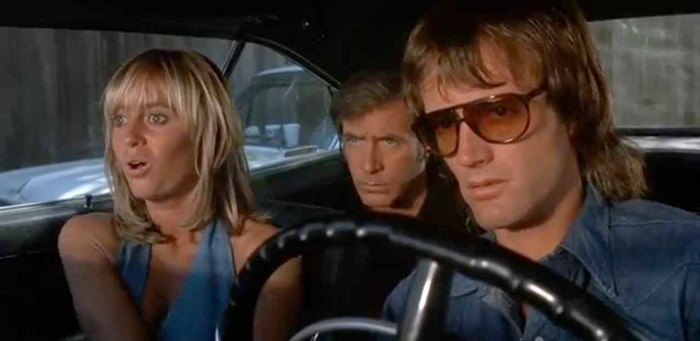
Dirty Mary, Crazy Larry (1974)
Why Edgar Loves It: Dirty Mary, Crazy Larry is another interesting one because in a similar vein to Vanishing Point, it's a car chase movie made in the wake of Bonnie and Clyde. The other interesting thing about Dirty Mary, Crazy Larry is, like Bullitt, it's another British director shooting it. I really like this movie because it's a pretty fun, disposable B-movie with great action. I always felt sorry for the actor Adam Roarke in it who plays Deke. He's in the movie for the entire thing. You assume in the movie that Adam Roarke is going to die at some point, but he's there right to the end, so it really should be called Dirty Mary, Crazy Larry and Deke. Why does this guy get left off the title? He's been there the whole time.
It's a really fun film but it has this sledgehammer bummer ending, which apparently director John Hough said they added to the script later because they felt like they couldn't just let these characters get away with it. So in the grand tradition of bummer endings in thrillers post-Bonnie and Clyde, like Easy Rider, Electra Glide in Blue and later Thelma & Louise even, I won't spoil it for anybody, but it's almost laugh out loud funny at how utterly brutal and out of left field it comes.
John Hough is a director that doesn't really get enough credit. If you watch some of his other films like The Legend of Hell House and Watcher in the Woods, he's a strong visual director with great low angles and wide shots. When I watched this movie I remember being very impressed by the camera work and his choices in the blocking of scenes.
Baby Driver Note: If there's a character in Baby Driver who could be compared to Deke in Dirty Mary Crazy Larry, it's Jon Bernthal's character, but Edgar Wright says it's still only a loose comparison.Edgar's Fun Fact: When I was a kid, I used to watch The Fall Guy with Lee Majors. And in the opening of The Fall Guy, there are lots of stunts from other movies. The stunts that you see in The Fall Guy are from films like Silver Streak or The Great Waldo Pepper, and the ending of Dirty Mary, Crazy Larry is in the opening credits of The Fall Guy.
***
That's all for part one of the 10 films that inspired Baby Driver. Make sure you see the movie, which is in theaters everywhere now, and come back tomorrow for the second round of films.

